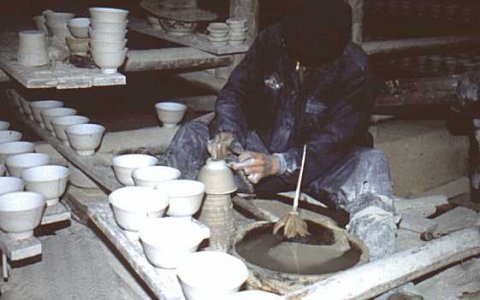
Description of the Twenty
Illustrations of the Manufacture of Porcelain
By Tang Ying, Director of the Imperial Factory at Jingdechen,
in obedience to an Imperial edict... (1743)

"It is only after the glazing and the painting of the decoration are finished
that this handle is removed by the polisher, who at the same time scoops out the foot."
Photo © Jan-Erik Nilsson, 1992
14. Turning the Unbaked Ware and Scooping out the Foot
"The size of the round piece has been fixed in the mold, but the smooth polish of the surface depends on the polisher, whose province is another branch of work, that of 'turning.'
He uses in his work the polishing wheel, which in form is like the ordinary potter's wheel, only it has projecting upward in the middle a wooden mandrel, the size of which varies, being proportioned to that of the porcelain which is about to be turned. The top of this mandrel, which is rounded, is wrapped in raw silk to protect the interior of the piece from injury. The piece about to be turned is put upon the mandrel, the wheel is spun round, and it is pared with the knife till both the inside and outside is given the same perfectly smooth polish. The coarser or finer finish of the form depends upon the inferior or superior handiwork of the polisher, whose work is consequently of great importance.
With regard to the next process, that of scooping out the foot, it is necessary, because each piece, when first fashioned upon the potter's wheel, has a paste handle left under the foot two or three inches long, by which it is held while it is being painted and glazed.
It is only after the glazing and the painting of the decoration are finished that this handle is removed by the polisher, who at the same time scoops out the foot, after which the mark is written underneath.
In the picture the workmen are seen occupied in the two processes of polishing the surface and scooping out the foot."
This page is based on an original translation from Chinese by S.W. Bushell, 1899, of a text written on Imperial command in 1743 by Tang Ying, the celebrated superintendent of the porcelain manufacture in the province of Jiangxi. It is widely reprinted. The version most likely to be authentic is the version found in the official annals of the province of Jianxi, Book XCIII, folio 19-23. The first draft seems to have been written in 1735. The version above was added to a set of 'twenty illustrations of the manufacture of porcelain' in 1743. The actual illustrations have never been identified. The text as it appears here is illustrated with photos taken on location by Jan-Erik Nilsson in 1991 and 1992.

